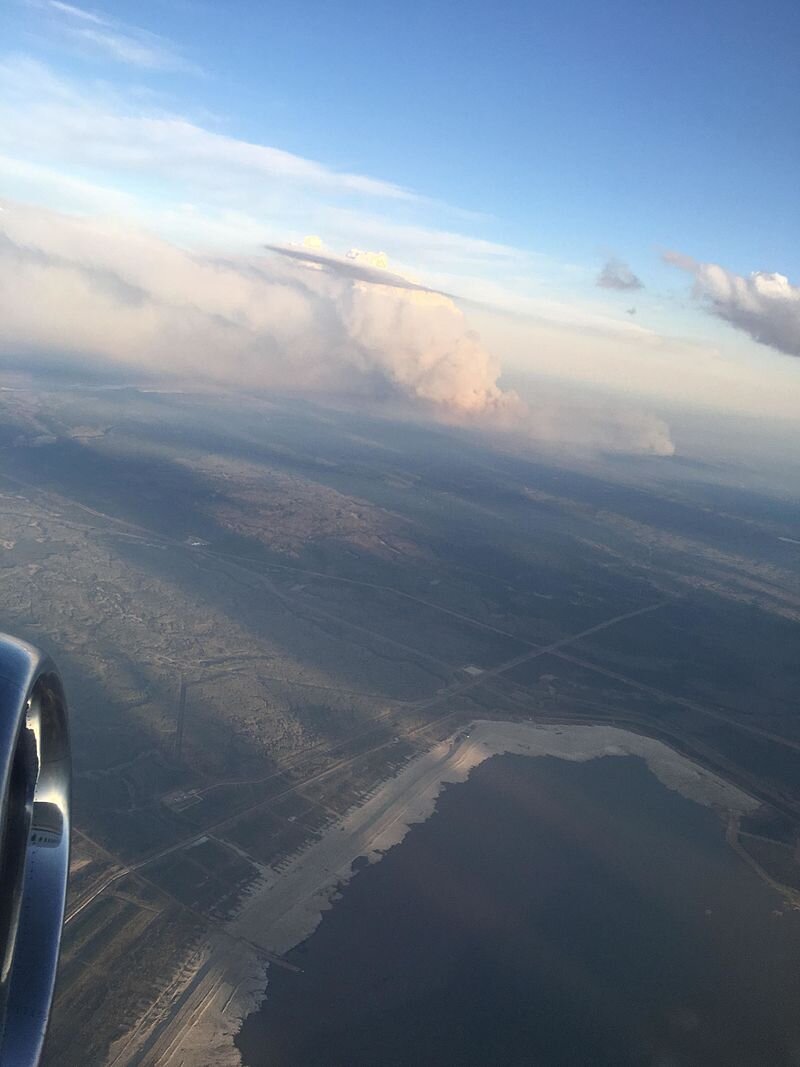
Part A. Air Pollution, its Causes and Effects
I. What is Air Pollution?
A blanket of wildfire smoke covers downtown Edmonton.
An air pollutant is anything that can harm human health or the environment when it is airborne. Air pollution is the combination of all air pollutants in the sky at a certain time. There are many kinds of air pollutants. Many of these pollutants can cause serious health problems.
Some kinds of pollution, like the wildfire smoke in this picture, can be seen with the naked eye. Many types of air pollution are invisible, but even invisible air pollution can still be harmful.
The effects of climate change will likely make air pollution even more dangerous in the coming years, which is why we need to learn to adapt to it.
II. Causes of Air Pollution
Industry
The smokestacks of an Edmonton oil refinery protrude into the blue sky.
Factories and other industrial buildings create much of the pollution in the air, both in Edmonton and around the world. The oil and gas industry especially releases many different kinds of pollutants, most of which are bad for human health.
Industrial buildings also release large amounts of greenhouse gases, which add to climate change.
Wildfires
The 2016 Fort McMurray wildfire, seen from the window of an airplane.
The smoke from wildfires like this one is full of many different kinds of air pollutants. This means that wildfire smoke is toxic, and can seriously affect your health if you breathe too much of it.
The wind can carry smoke from forest fires far away from the site of the original fire. This means that wildfire smoke can end up in Edmonton from as far away as B.C. In fact, most of the really bad air days that we have here in Edmonton are caused by smoke from Canadian wildfires.
For more information on wildfire smoke and its impact on your health, visit Wildfire Smoke and Your Health Canada
Attribution: “Smoke and fire from Fort McMurray Wildfire, from plane’s view” by DarrenRD is licensed under CC BY-SA 4.0. The licensor does not endorse this use of the material.
Traffic
Cars wait at a stop light as a group of ducks swim on the surface of a small lake below.
Large traffic build-ups like this one are another major cause of air pollution. Car exhaust contains many harmful pollutants, and when many cars all drive on a road at once, that pollution can build up. This is the reason that air quality is often worse near large roads with lots of traffic.
Pollen
A pine tree releases a large cloud of pollen into the air.
Plants are a great thing to have in any city. They can help with climate change mitigation and adaptation, and they can even absorb air pollutants directly out of the air. However, plants also add to air pollution, in their own special way.
During the spring and summer, plants release tiny granules called pollen grains into the air. Some people are allergic to pollen, and will start sneezing or get a runny nose when they breathe it in. Pollen usually doesn’t cause serious health problems in people who are allergic to it, but it can be very annoying.
Climate change will cause more pollen to be released into the air. This means that many people will likely see their pollen allergies getting worse as climate change continues.
This work, “Pollen Tree”, is a derivative of “Pollen from pine tree 2” by Beatriz Moisset, used under CC BY-SA 3.0. “Pollen Tree” is licensed under CC BY-SA 3.0 by Markus Gaenzle.
III. Impacts of Air Pollution on Health
A man wearing a face mask looks ahead as a cloud of smoke floats past his face. Note that the surgical mask the man is wearing in the picture will not protect you from most forms of air pollution.
Smoke and other kinds of air pollution can harm human health in many ways. When you breathe in lots of pollution, you may start to get tired, or you may get a headache or cough. You may also start to have a hard time breathing, or your eyes, nose or skin could become irritated by the pollution. Children, older adults and people who spend lots of time outside are more likely to get these short-term symptoms.
Air pollution can also worsen lung or heart conditions you may already have. Asthma, chest pain (Angina) and heart failure are all examples of conditions that air pollution can make even more difficult to deal with.
Sometimes, the effects of air pollution can be fatal. According to the Government of Canada, air pollution helps cause the deaths of over 14 000 people in Canada a year.
For more information on the health effects of air pollution, go to https://www.canada.ca/en/health-canada/services/air-quality/health-effects-indoor-air-pollution.html
Sources:
Environment and Climate Change Canada. (2017, February 10). Air Pollutants Overview. Retrieved July/August, 2020, from https://www.canada.ca/en/environment-climate-change/services/air-pollution/pollutants/overview.html
Environment and Climate Change Canada. (2017, May 23). Sources of air pollution. Retrieved July/August, 2020, from https://www.canada.ca/en/environment-climate-change/services/air-pollution/sources.html
Environment and Climate Change Canada. (2020, July 23). Wildfire Smoke and Your Health. Retrieved July/August, 2020, from https://www.canada.ca/en/environment-climate-change/services/air-quality-health-index/wildfire-smoke/wildfire-smoke-health.html
Health Canada. (2016, July 08). Road Traffic and Air Pollution. Retrieved July/August, 2020, from https://www.canada.ca/en/health-canada/services/air-quality/road-traffic-air-pollution.html
Health Canada. (2016, March 23). Health Effects of Air Pollution. Retrieved July/August, 2020, from https://www.canada.ca/en/health-canada/services/air-quality/health-effects-indoor-air-pollution.html
Health Canada. (2018, January 31). Smog and your health. Retrieved July/August, 2020, from https://www.canada.ca/en/health-canada/services/air-quality/smog-your-health.html
Kerr, M. (1978, March 22). Pollen Allergies: Types, Symptoms, and Treatment. Retrieved July/August, 2020, from https://www.healthline.com/health/allergies/pollen
Warren, F.J. and Lemmen, D.S., editors (2014): Canada in a Changing Climate: Sector Perspectives on Impacts and Adaptation; Government of Canada, Ottawa, ON, 286p.






